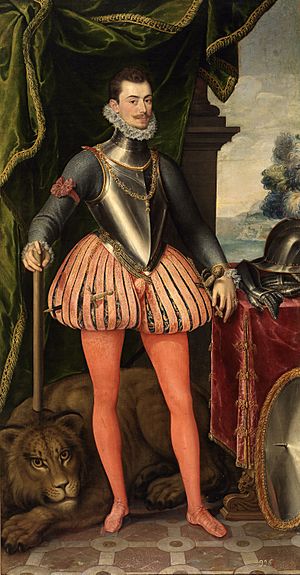Spanish breeches facts for kids

Spanish breeches (called gregüescos in Spanish) were a type of short, baggy trousers worn by men. They were often worn with a special pouch called a codpiece. These breeches were very popular in Spain from the 1500s to the 1600s. They might have first been used by soldiers.
Over time, Spanish breeches changed their look and length. They became popular in other parts of Western Europe and in Spanish lands overseas. They developed from earlier types of hose or pants. Famous writers like Lope de Vega and Francisco de Quevedo wrote about them. Important artists such as Diego Velázquez and Titian also painted people wearing them.
Contents
What Are Spanish Breeches?
Spanish breeches were a unique style of men's pants. They were short, usually ending above the knee. A key feature was their very baggy shape, similar to what we might call "harem pants" today. Unlike some other pants, they were not gathered tightly at the bottom.
This style was quite different from the tight-fitting hose or leggings worn before. The loose fit allowed for more movement. They were a clear fashion statement during their time.
A Look at History
Spanish breeches were most fashionable during the 16th and early 17th centuries. This was a time when Spain was a very powerful country. Its fashion trends often spread across Europe. The breeches were a symbol of the Spanish style of the era.
They evolved from earlier forms of leg coverings. As fashion changed, these breeches also changed. They led to other styles of pants that became popular later on.
Spanish Breeches in Art and Literature
Many famous artists painted people wearing Spanish breeches. These paintings show us exactly how they looked and how they were worn. Artists like Diego Velázquez captured the details of these clothes in their portraits.
Writers of the Spanish Golden Age also mentioned these breeches in their plays and books. Sometimes they described them in detail. Other times, they made fun of them, showing how popular and sometimes over-the-top they could be. This helps us understand how people felt about fashion back then.
See Also
- In Spanish: Gregüescos para niños

